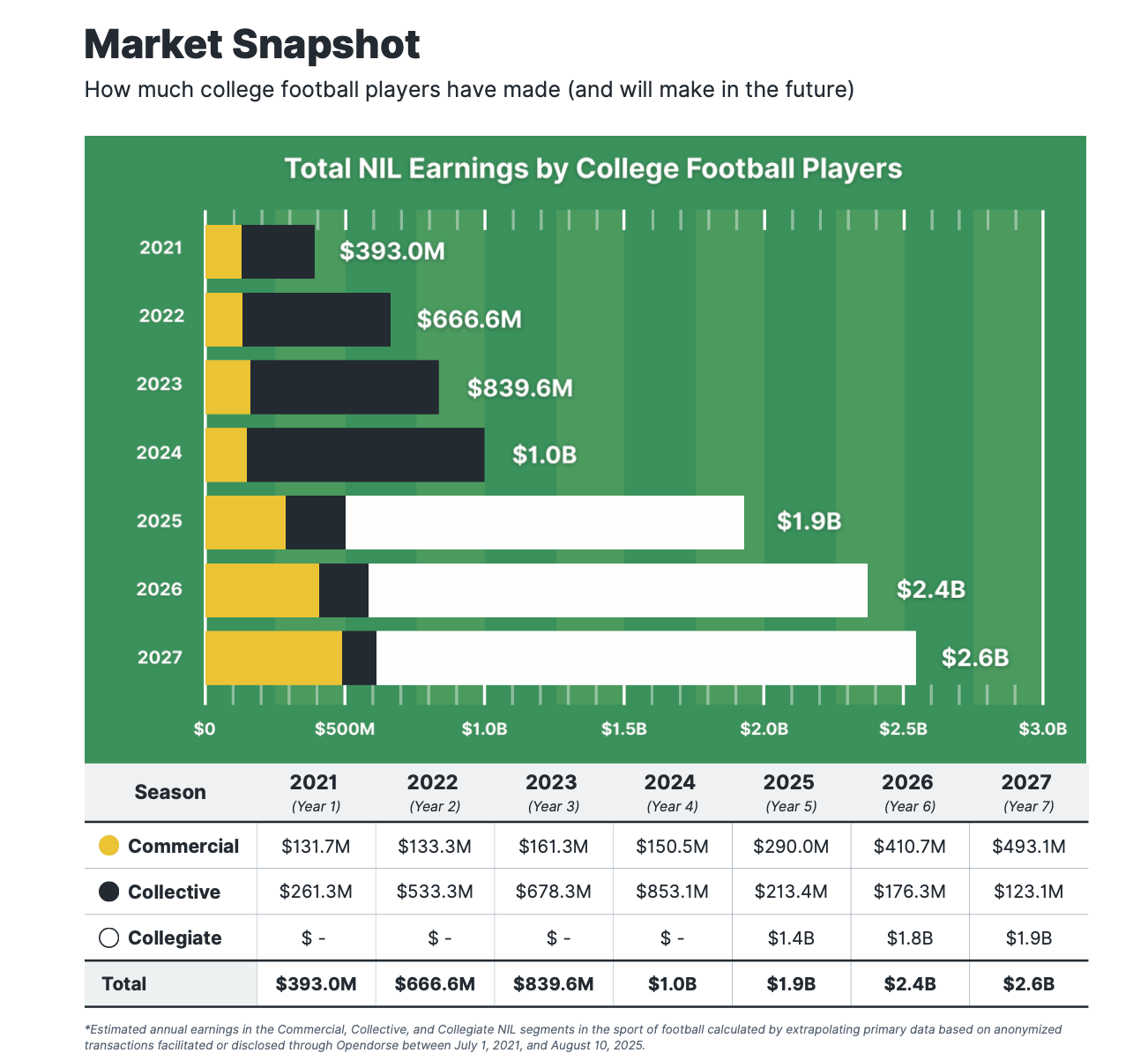- NIL Wire
- Posts
- 🏅 Inside the Opendorse report: Breaking down college football earnings
🏅 Inside the Opendorse report: Breaking down college football earnings
We learned a lot about how conferences are allocating money, how much players are earning across the board and how revenue-sharing payments stack up against total revenue generated
Hey there,
Welcome back to NIL Wire. In today’s newsletter, we’re diving into how money is moving through college football after Opendorse just released an in-depth report with data that is “based on verified, anonymized NIL payments, disclosures, and budgets from collectives and colleges between July 1, 2021 and August 10, 2025.”
Let’s get into it.
— Deyscha
Inside the Opendorse report: Breaking down college football earnings
When someone mentions revenue sharing and NIL, it’s easy to get lost in the sauce of big-name brand deals and player valuations that seem wild. Quarterbacks with seven-figure deals? Okay, fine, even I shared that ESPN story.
But Opendorse’s “College Football Kickoff” report, which uses data from Power 4 schools, allows us to zoom out. The info it contains, as well what we know from the Extra Points Library, helps paint a broader picture of what’s happening in college football right now.
NIL earnings are growing (and growing)
According to the report, P4 football players earned a total of $393.3 million in 2021. Fast forward to last year, and that number rose to a whopping $1 billion. Those totals are broken down into commercial and collective earnings, and though collective earnings have always been significantly higher than commercial totals, they skyrocketed last year. In 2024, college football players brought in more than five times as much through collectives than they did commercial earnings.
That’s projected to change this year, with the House settlement and the way it’s restrained collectives. This year, it’s estimated that P4 college football players will earn $70 million more in commercial earnings, and in the coming years, collective earnings are projected to shrink further. With revenue sharing now coming into play, players' total earnings will likely double this year. Here’s the full breakdown of total earnings, year by year:
2021: $393 million
2022: $666.6 million
2023: $839.6 million
2024: $1 billion
2025: $1.9 billion

Source: Opendorse
Revenue is going to players — and schools are looking for ways to compensate
One of the most interesting pieces of information in the report is that P4 football players’ earnings account for 13.1 percent of the revenue schools generated. Group of 6 players’ earnings are a little bit higher, at 13.3 percent. As programs deal with rising expenses, how are athletic directors getting more creative with generating revenue? The Athletic looked into that question in a recent story about spending across college sports.
“How do we use data to be more strategic about deploying those assets, whether it’s premium seating, tickets, merchandise, fundraising, special events?” Ohio State athletic director Ross Bjork said to the Athletic. “We are not using data effectively to really market and target different groups.”
We know from FRS Report data in the Extra Points Library that Texas led the country in ticket sales revenue last year (as well as in total operating expenses). What about fundraising? Another SEC school, Missouri, led in that category.
Athletic departments right now are partnering with brands and finding ways to leverage what they have to offer, whether it’s inside stadiums or through branding opportunities, content, alcohol or giving brands direct access to market to their fans. That’s obvious in the deals and partnerships that were announced this week:
Auburn partnered with Dude Wipes, which also made quarterback Jackson Arnold its new brand ambassador. The deal also includes branding across Jordan-Hare Stadium, courtside signage at the basketball arena and activations. In July, Auburn also reimagined its content network, War Eagle+, a subscription-based service that gives access to exclusive content.
Florida, Syracuse, TCU, Ohio State and Alabama are partnering with Evan Williams Bourbon in a deal that also includes in-stadium signage, branded bar experiences and dynamic tailgate events.
Indiana inked a 20-year, $50 million deal with Merchant Bank for naming rights to its football stadium.
Some more insight into player earnings
We already know from ESPN’s reporting that in college football, programs are allocating their revenue-sharing budgets to specific positions. Here’s what’s happening in each conference, based on Opendorse’s report:
The Big 12 is allocating most of its rev-share budget to:
quarterbacks (23.1%)
defensive backs (14.4%)
wide receivers (11.5%)
running backs (10.8%)
The Big Ten is allocating its budget to:
wide receivers (16.8%)
offensive lineman (15.5%)
quarterbacks (14.4%)
defensive backs (13.1%)
The ACC is allocating its budget to:
quarterbacks (19.4%)
offensive linemen (17.0%)
wide receivers (16.3%)
defensive linemen (15.5%)
The SEC is allocating its budget to:
wide receivers (15.9%)
defensive linemen (15.5%)
quarterbacks (15.1%)
offensive linemen (14.4%)
As for how much the players are making, well, that number might surprise you, too. Don’t be fooled by the headlines these days (trust me, I get it; articles with big names and multimillion-dollar figures generate more clicks); the reality is that 66.5 percent of P4 college football players are earning less than $10,000 annually, and only 0.3 percent are bringing in more than $1 million.
Here’s the full breakdown:
66.5% are earning less than $10,000
16.1% are earning between $10,000 and $49,000
7.4% are earning between $50,000 and $99,000
9.1% are earning between $100,000 and $499,000
0.6% are earning between $500,000 and $999,000
0.3% are earning more than $1 million
I’m going to keep it real with you, seeing this puts a lot into perspective. The numbers are one thing, but it makes me think about the players — current, former and future — and how they’re handling all of this. Would former star athletes have stayed longer if they had NIL? (Johnny Manziel said last year that he would’ve stayed at Texas A&M, Opendorse’s report projects that he would’ve earned $3.2 million if he were playing college football this season.)